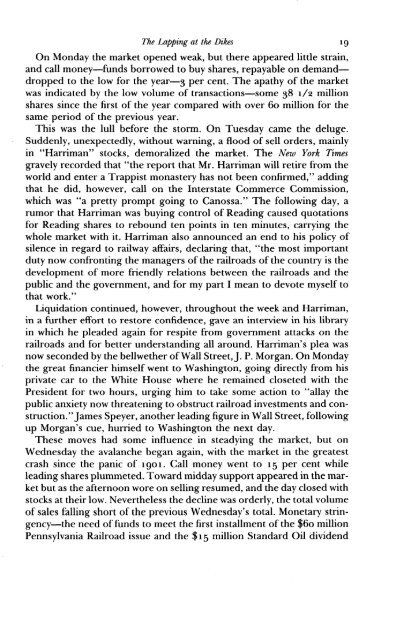You also want an ePaper? Increase the reach of your titles
YUMPU automatically turns print PDFs into web optimized ePapers that Google loves.
The Lapping at the Dikes 19<br />
On Monday the market opened weak, but there appeared little strain,<br />
and call money-funds borrowed to buy shares, repayable on demanddropped<br />
to the low for the year-3 per cent. The apathy of the market<br />
was indicated by the low volume of transactions-some 38 1/2 million<br />
shares since the first of the year compared with over 60 million for the<br />
same period of the previous year.<br />
This was the lull before the storm. On Tuesday came the deluge.<br />
Suddenly, unexpectedly, without warning, a flood of sell orders, mainly<br />
in "Harriman" stocks, demoralized the market. The New York Times<br />
gravely recorded that "the report that Mr. Harriman will retire from the<br />
world and enter a Trappist monastery has not bet;n confirmed," adding<br />
that he did, however, call on the Interstate Commerce Commission,<br />
which was "a pretty prompt going to Canossa." The following day, a<br />
rumor that Harriman was buying control of Reading caused quotations<br />
for Reading shares to rebound ten points in ten minutes, carrying the<br />
whole market with it. Harriman also announced an end to his policy of<br />
silence in regard to railway affairs, declaring that, "the most important<br />
duty now confronting the managers of the railroads of the country is the<br />
development of more friendly relations between the railroads and the<br />
public and the government, and for my part I mean to devote myself to<br />
that work."<br />
Liquidation continued, however, throughout the week and Harriman,<br />
in a further effort to restore confidence, gave an interview in his library<br />
in which he pleaded again for respite from government attacks on the<br />
railroads and for better understanding all around. Harriman's plea was<br />
now seconded by the bellwether ofWall Street,J. P. Morgan. On Monday<br />
the great financier himself went to Washington, going directly from his<br />
private car to the White House where he remained closeted with the<br />
President for two hours, urging him to take some action to "allay the<br />
public anxiety now threatening to obstruct railroad investments and construction."James<br />
Speyer, another leading figure in Wall Street, following<br />
up Morgan's cue, hurried to Washington the next day.<br />
These moves had some influence in steadying the market, but on<br />
Wednesday the avalanche began again, with the market in the greatest<br />
crash since the panic of 1901. Call money went to 15 per cent while<br />
leading shares plummeted. Toward midday support appeared in the market<br />
but as the afternoon wore on selling resumed, and the day closed with<br />
stocks at their low. Nevertheless the decline was orderly, the total volume<br />
of sales falling short of the previous Wednesday's total. Monetary stringency-the<br />
need offunds to meet the first installment of the $60 million<br />
Pennsylvania Railroad issue and the $15 million Standard Oil dividend

















